Have you seen those 3-page checklists for baby-proofing? Are all of those steps really necessary? Or should you just put a helmet on your child and duct tape pool noodles to every piece of furniture in the house? Really, what are child-proofing steps you should take? Here are the top tips from American Academy of Pediatrics, Mayo Clinic, and the CDC. Additionally, Dr. Dennis Clements, MD, PhD, a pediatrician and the Chief of Primary Care at Duke Children’s Hospital, offers his perspective on injuries and priorities, as your curious, beloved troublemaker starts getting into everything.
“Not many injuries happen until the child starts exploring,” indicates Dr. Clements. “Before that, most injuries are preventable with a little extra awareness and forethought’.” Infant injuries typically include hot drink spills, fingers closed in drawers or car doors, strollers tipping, or babies falling from a changing table or high chair. Some basic precautions, extra awareness, and use of safety belts go a long way to prevent these.
Once a child starts exploring, though, it’s a different story. “Then they get into everything. You’ve got to get everything out of the cabinets that they can get to from the ground,” explains Dr. Clements. He adds that it’s especially important to supervise kids closely when traveling. “That’s probably where they get into grandma’s heart medicine, because it’s sitting there on the table.” Here are the real essentials for preventing injuries to your little explorer include:
- Remove dangerous substances from low cabinets. Move solvents, cleaning products, bleach, detergent, personal hygiene chemicals to an out-of-reach location. Don’t forget to check your basement or garage for antifreeze, liquids for car maintenance, and insecticides.
- Know the Poison Control number. In the United States, poison control can be reached at 1-800-222-1222. If your child collapses or isn’t breathing, call 911.
- Beware of small objects: Small objects like beads, buttons, coins, pins, or screws can be a choking hazard.
- Secure the Trash. Use a cabinet lock to secure the trash. Be sure to discard of dangerous items like razor blades, batteries, or medications in ways that kids won’t be able to accidentally access them.
- Prevent falls. The CDC indicates that falls are the leading cause of non-fatal injuries for all children ages 0 to 19. You can reduce risks by using baby gates to control access to stairs and placing guards on windows that are above ground level. Also, avoid allowing a young child to play alone on a balcony, fire escape or high porch. Last, address slippery or uneven surfaces like bathtubs, slippery rugs, or chipped steps.
- Cushion the blow. Cover sharp furniture and fireplace corners with corner bumpers, or choose a soft ottoman instead of a coffee table.
- Prevent burns. Adjust your home’s water heater temp to below 120 F or 48.9C. Prevent contact with hot objects, by unplugging irons and using cold-water humidifiers/vaporizers.
- Child-proof electrical outlets. Cover unused electrical outlets or get child-safe electrical outlets. Mayo Clinic indicates that inserting a fork, key or other metal object into an outlet could result in a serious electrical burn. It’s also a good idea to replace damaged or frayed electrical cords, to prevent children chewing on them.
- Bolt heavy furniture to the wall. According to Safe Kids Worldwide, every 45 minutes, a child visits the emergency room because of a TV tipping over. And, we all know kids who try to climb furniture and hang from drawers (possibly all kids, eventually?). Prevent injury by bolting heavy furniture to the wall to prevent it falling over on top of a child.
– – -
A special thanks to Dr. Clements for offering his insight for this article. If you enjoyed this article and would like to see more from Mama Lovejoy, check out our website or like our blog.
